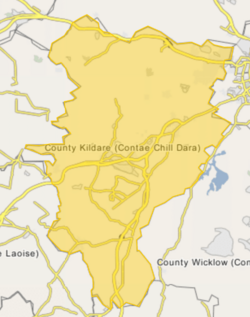Furness Church facts for kids
Quick facts for kids Furness Church |
|
|---|---|
| Forenaghts Church | |
|
Séipéal Fhornochta
|
|
| 53°13′24″N 6°36′05″W / 53.223363°N 6.601476°W | |
| Location | Forenaghts Great, County Kildare, Ireland |
| Country | Ireland |
| Denomination | Church of Ireland |
| Previous denomination | Pre-Reformation Catholic |
| History | |
| Founded | 13th century |
| Architecture | |
| Style | Gothic |
| Administration | |
| Diocese | Kildare and Leighlin |
Furness Church is a very old church from the 1200s, built by the Normans in County Kildare, Ireland. It is a special historical site that helps us understand life many centuries ago.
Contents
Where is Furness Church?
Furness Church is located near Furness House. It is about 2 kilometers (1.3 miles) southeast of Johnstown in County Kildare.
The History of Furness Church
The church stands on the grounds of Furness House. This land was once owned by Adam de Hereford after the Norman conquest of Ireland around 1169. He later gave the land to a monastery in Dublin called the Abbey of St Thomas the Martyr.
How the Church Grew Over Time
The church started as an Early Christian building around 500 AD. The Normans extended it in 1210. This extension added a roof, making it a proper place for people to gather and worship. The name Furness comes from the Irish word fornocht, which means "bare hill."
Changes After the Monasteries Closed
In the 1530s, many monasteries in Ireland were closed down by the Crown. This event is known as the Dissolution of the Monasteries. The land at Furness, including the church, was then bought by the Ashe family, who were merchants from Naas.
Special Features of the Church Building
The church has unique doors and windows. They are edged with a material called tufa. Tufa is a type of limestone that was popular with Cistercian monks in Europe starting around 1150.
What is a Leper Window?
One interesting feature is a "leper window." These were small openings in old churches. They allowed people with diseases, like leprosy, to listen to the church service from outside. This way, they could still be part of the community without spreading illness. Today, these windows are usually blocked up.
Later Years and Burials
At some point, Furness Church was damaged by fire and then left empty. Even though the Nevill family, who owned the land later, were Protestant, they allowed local Catholic families to continue burying their loved ones around the church. This meant people could be buried alongside their ancestors.
Gravestones and Famine Relief
One gravestone from the early 1700s has the symbol IHS. This symbol often marked a Catholic burial. Burials at the church stopped in the 1840s. At that time, the owners built a wall around the estate. This project was a way to provide work and help people during the famine.


